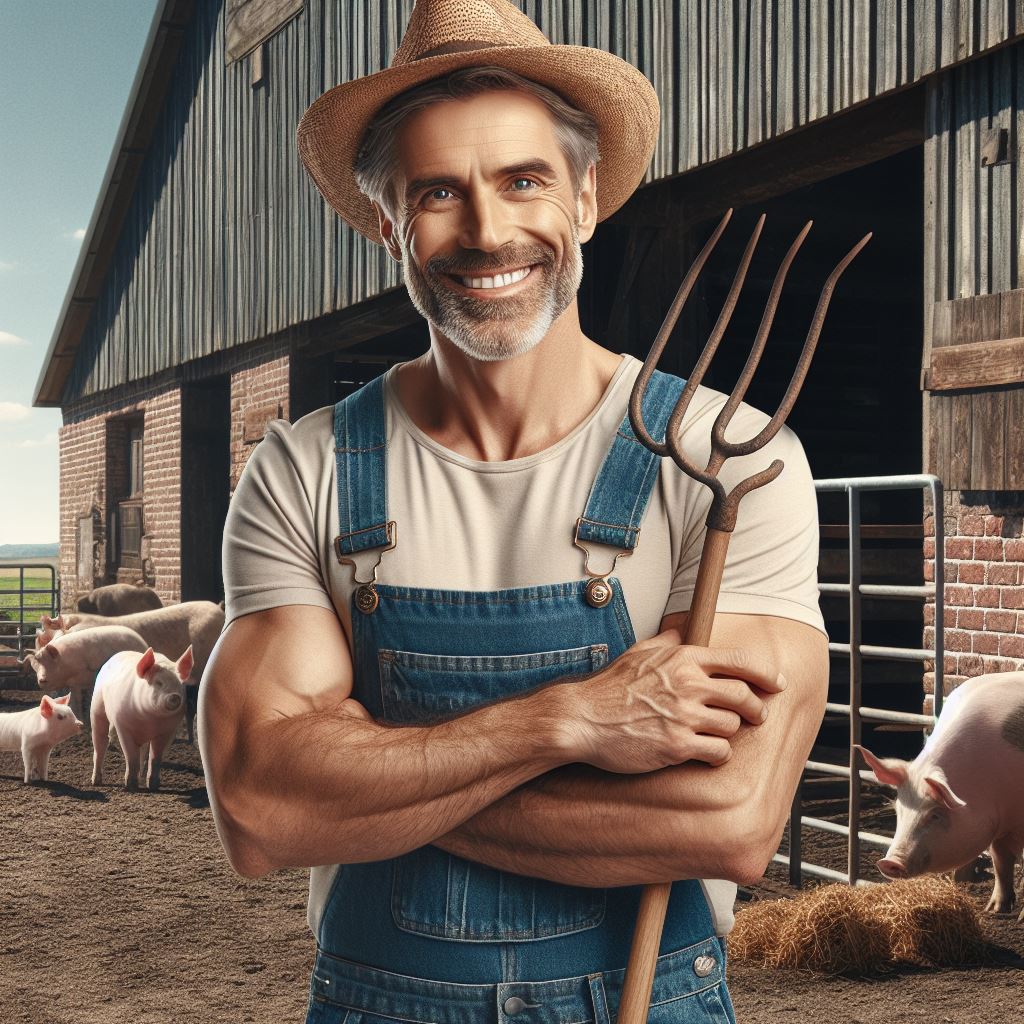Introduction
Embarking on pig farming?
This beginner’s guide is your compass in navigating the essentials.
From selecting breeds and constructing pens to nutritional needs and health management, delve into the world of pig farming.
Unlock the key insights that pave the way for a successful and rewarding venture.
Importance of pig farming
Pig farming plays a crucial role in ensuring food security and providing a sustainable source of income for farmers.
Purpose of the blog post
The purpose of this blog post is to provide a comprehensive guide for beginners interested in pig farming, covering essential aspects and tips for success.
Getting Started with Pig Farming
Choosing the right pig breed
Consider the characteristics of the pig breed to ensure it aligns with your farming goals.
Popular pig breeds for beginners include Hampshire, Yorkshire, Duroc, and Berkshire.
Setting up suitable housing for pigs
Explore different types of pig housing such as pens, barns, or pastures to find the most suitable option.
Pig housing should meet requirements such as good ventilation, proper drainage, and adequate space for pigs.
Read: Cost-Efficient Pig Farming Tips
Feeding and Nutrition
Understanding pig nutrition needs
Pigs require essential nutrients to maintain optimal health and productivity
These nutrients include proteins, carbohydrates, fats, vitamins, minerals, and water.
Proteins are crucial for muscle development and repair, while carbohydrates provide energy for daily activities.
Fats are essential for hormone production and insulation.
Transform Your Agribusiness
Unlock your farm's potential with expert advice tailored to your needs. Get actionable steps that drive real results.
Get StartedFurthermore, pigs need vitamins and minerals to support various physiological functions.
Water is vital for digestion, nutrient absorption, and overall hydration.
Understanding these nutritional needs is essential for proper pig farming management
Feeding requirements at different stages
Feeding requirements vary depending on the pig’s age, growth rate, and production purpose.
For piglets, milk from the sow is their primary source of nutrition during the first few weeks.
After weaning, piglets should be gradually introduced to solid feeds to prevent digestive issues.
Regular checks on body condition, weight, and growth rate help determine appropriate feeding strategies.
Growing pigs, especially in the early stages, require feeds rich in proteins and energy to support rapid growth.
On the other hand, pregnant and lactating sows require higher energy feeds to meet their increased nutrient demands.
Understanding the specific feeding requirements at different stages ensures healthy and productive pigs.
Types of pig feed
There are two main types of pig feed available, namely commercial pig feed and homemade pig feed.
Commercial pig feed
Commercial pig feed is readily available in the market and often preferred by pig farmers.
These feeds are carefully formulated to meet the specific nutritional needs of pigs at different stages.
All essential nutrients, including vitamins and minerals, are included in the right ratios.
Commercial pig feed ensures convenience and saves time in formulating feed rations.
Homemade pig feed
Homemade pig feed is an alternative for farmers who prefer a more personalized approach.
It involves formulating pig feeds using locally available ingredients.
While cheaper, farmers need to ensure that the feeds provide all necessary nutrients in appropriate amounts.
Seeking advice from pig nutrition experts is crucial to ensure balanced homemade pig feed.
Feeding and nutrition play a vital role in the overall performance and health of pigs.
Understanding the essential nutrients required by pigs, their feeding requirements at different stages, and the types of pig feed available allows farmers to make informed decisions.
Whether opting for commercial pig feed or homemade alternatives, it is crucial to ensure a balanced diet that meets the pigs’ specific nutritional needs.
By providing the right feed, pig farmers can promote growth, enhance productivity, and maintain the overall well-being of their animals.
Read: Organic Feed for Healthy Pigs
Showcase Your Farming Business
Publish your professional farming services profile on our blog for a one-time fee of $200 and reach a dedicated audience of farmers and agribusiness owners.
Publish Your ProfileHealth and Disease Management
Common pig diseases and prevention measures
Vaccinations for pigs
Vaccinating pigs is crucial in preventing various diseases such as swine fever and respiratory infections.
Consult a veterinarian for the appropriate vaccination schedule.
Biosecurity practices
Implementing strong biosecurity measures, including controlled access, proper sanitation, and quarantine protocols, can significantly reduce the risk of disease transmission within your pig farm.
Signs of illness in pigs
How to monitor pig health
Regularly observe your pigs for any changes in behavior, appetite, or physical appearance.
Unusual symptoms like coughing, diarrhea, or lethargy may indicate an underlying health issue.
When to seek veterinary care
If you notice persistent or severe signs of illness in your pigs, it is essential to seek professional veterinary care promptly.
Early intervention can prevent the spread of diseases and increase the chances of recovery.
Read: Managing Pig Health: Disease Control
Pig Breeding and Reproduction
Proper breeding and reproduction management are essential for a successful pig farming operation.
It is crucial to understand the pig breeding cycle, detect estrus in sows, and employ appropriate methods for breeding.
Additionally, adequate care during pregnancies and farrowing ensures the health and well-being of both the mother sow and her offspring.
Understanding the pig breeding cycle
The pig breeding cycle consists of different stages, each requiring specific attention and action.
To ensure successful breeding, understanding these stages is crucial.
Estrus detection in sows
Estrus, or heat, is the period when sows are receptive to mating.
It is essential to detect estrus accurately to optimize breeding efficiency.
Signs of estrus include increased vocalization, swollen vulva, restlessness, and mounting other pigs.
Methods for Pig Breeding
There are various methods for pig breeding, including natural mating and artificial insemination.
Natural mating involves introducing a boar to a sow in heat, ensuring appropriate supervision and safety measures.
Artificial insemination is a more controlled method that allows breeders to use superior genetics and ensure accurate timing.
Managing pig pregnancies and farrowing
Proper management of pig pregnancies and farrowing is vital for the health and survival of both the mother sow and the newborn piglets.
Preparing for farrowing
Before farrowing, it is essential to provide the sow with a clean and comfortable farrowing pen.
Ensure there is enough space for the sow to move but small enough to prevent piglet crushing.
Provide proper nutrition and ensure all necessary equipment, such as heat lamps and farrowing mats, are in place.
Care of newborn piglets
After farrowing, closely monitor the newborn piglets for any signs of distress or weakness.
Ensure they have access to the sow’s milk and provide supplementary heat if required.
Regularly check their body temperature, ensuring it stays within the normal range.
Additionally, provide appropriate vaccination and deworming protocols as recommended by a veterinarian.
By understanding the pig breeding cycle, accurately detecting estrus, employing suitable breeding methods, and effectively managing pregnancies and farrowing, pig farmers can maximize breeding efficiency and improve overall production.
It is crucial to stay updated on the latest practices and consult with experts in the field to ensure optimal results.
Read: Innovations in Swine Welfare

Pig Farming Equipment and Tools
Essential tools for pig farming
Pig farming involves various tasks that require specific tools. Here are two essential categories:
Feeding and watering equipment
Pig feeding requires appropriate tools to ensure they receive proper nutrition:
Feeding troughs
These are containers used to hold feed for the pigs.
They should be sturdy, easily accessible, and easy to clean.
Watering systems
Pigs need access to fresh and clean water at all times
Watering equipment can include nipple drinkers, automatic waterers, or water troughs.
Handling and waste management tools
Pig handling and waste management require specific tools to maintain cleanliness and facilitate proper waste disposal:
- Sorting boards: These long boards with handles are used to guide and separate pigs during sorting or loading.
- Shovels and pitchforks: These tools are used to clean pens and remove waste.
- Manure scoops: Scoops are useful for collecting manure and transferring it to designated areas.
Automated systems for pig farming
Advancements in technology have introduced automated systems that bring convenience and efficiency to pig farming operations.
Advantages and considerations
Automated systems offer several advantages for pig farmers:
- Time-saving: These systems automate labor-intensive tasks, reducing the time and effort required for manual feeding and watering.
- Consistency: Automated systems ensure consistent feeding and watering, reducing the risk of under or overfeeding.
- Improved efficiency: These systems optimize feed usage, reducing waste and controlling costs.
However, there are certain considerations to keep in mind when using automated systems:
Showcase Your Farming Business
Publish your professional farming services profile on our blog for a one-time fee of $200 and reach a dedicated audience of farmers and agribusiness owners.
Publish Your ProfileInitial investment
Purchasing and installing automated systems can be expensive. Farmers must carefully consider their budget and evaluate the potential return on investment.
Maintenance and troubleshooting
Automated systems require regular maintenance and occasional troubleshooting. Farmers should have proper knowledge and skills for maintenance or access to technical support.
Examples of automated systems
Several automated systems are commonly used in pig farming:
- Automatic feeding systems: These systems dispense the right amount of feed at specific times, ensuring pigs receive adequate nutrition.
- Temperature control systems: These systems monitor and adjust temperature levels in the pig housing, providing optimal conditions for pig health and growth.
- Electronic identification systems: These systems use tags or electronic devices to track and identify individual pigs, enabling better monitoring and management.
Essentially, the right equipment and tools are vital for successful pig farming.
Feeding and watering equipment, as well as handling and waste management tools, are essential for day-to-day operations.
Additionally, considering and implementing automated systems can bring numerous benefits, but thorough evaluation and maintenance are necessary.
By utilizing the right tools and equipment, pig farmers can create a healthy and efficient farming environment for their animals.
Marketing and Economic Considerations
When starting a pig farming business, it is essential to consider marketing and economic factors to ensure success.
In this section, we will explore how to find markets for pig products and understand the economics of pig farming.
Finding markets for pig products
Pig farmers need to identify and tap into markets where they can sell their pig products.
Two key market options include local and regional markets, as well as online platforms and direct sales channels.
Local and regional markets
Local and regional markets offer opportunities for pig farmers to sell their products to nearby customers.
These markets can include grocery stores, restaurants, food co-ops, and farmers’ markets.
Building relationships with local buyers and understanding their specific requirements can help pig farmers establish a steady customer base.
Online platforms and direct sales
With the rise of e-commerce, pig farmers can leverage online platforms and direct sales channels to reach a wider customer base.
Creating an online presence through a website or social media platforms allows farmers to showcase their products and directly engage with potential customers.
Direct sales can be made through online marketplaces or by setting up an online store on their website.
Understanding the economics of pig farming
To ensure profitability, it is crucial for pig farmers to understand the economics of their business.
This involves assessing costs and returns, as well as planning for long-term profitability.
Costs and returns
Pig farmers need to carefully analyze the costs involved in pig farming, including expenses for feed, housing, healthcare, and transportation.
They should also evaluate the potential returns from selling pig products, considering market prices, demand, and competition.
By understanding their costs and projected returns, farmers can make informed decisions to optimize their profitability.
Planning for profitability
Planning is crucial for achieving profitability in pig farming.
Farmers should create a detailed business plan that outlines their goals, strategies, and financial projections.
This includes setting competitive prices for their products, implementing efficient production practices, and exploring potential revenue streams such as value-added products or agritourism.
Regular monitoring and assessment of the business performance will allow farmers to make necessary adjustments and continually work towards maximizing profitability.
Generally, marketing and economic considerations play a vital role in the success of pig farming.
Finding markets for pig products, both locally and online, helps farmers expand their customer base and increase sales.
Understanding the economics of pig farming, including costs, returns, and planning for profitability, ensures long-term sustainability and profitability in the industry.
Conclusion
Recap of key points covered in the blog post
In this blog post, we have covered the essentials of pig farming, starting from understanding the different breeds of pigs and their specific needs.
We discussed the importance of selecting the right location for your pig farm, ensuring proper housing and hygiene, and providing a balanced diet to the pigs.
Additionally, we highlighted the significance of regular health check-ups, vaccination, and proper waste management.
Encouragement for beginners to start pig farming
If you are a beginner interested in pig farming, this guide has provided you with valuable information to get started.
By following the key points mentioned, you can establish a successful and profitable pig farming venture.
Though it may require initial hard work and investment, the rewards outweigh the challenges.
Pig farming not only offers a lucrative business opportunity but also provides individuals with a sustainable source of income.
With comprehensive knowledge and dedication, you can overcome any obstacles and flourish in this industry.
So, take the leap and embark on your journey as a pig farmer today!




